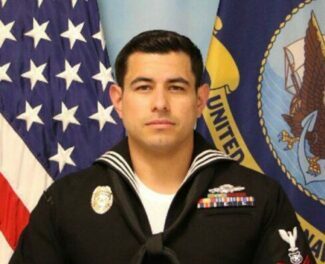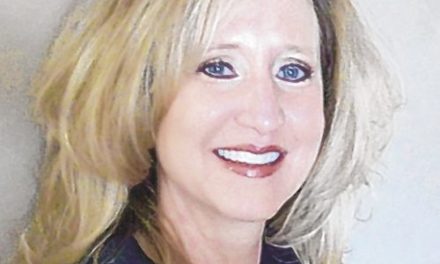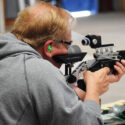John Chavez remembers the day when he was reading a copy of “Boy’s Life,” the Boy Scouts’ monthly magazine. John happened to notice an ad in the magazine’s back pages. The ad was for the New Mexico Military Institute (NMMI). The 14-year-old Belenite got interested, cut out the ad and mailed it in for more information about the school and its campus in Roswell.
John had been born into a family that dated back five generations in the Belen community. His parents, Robert and Rosalyn Chavez, could not have given him a better home or taught him better values as a child.
John also had many good public-school teachers. Maggie McDonald remembers him as one of her best students at Central Elementary School. And he always enjoyed the Boy Scouts, their activities and code of honor.
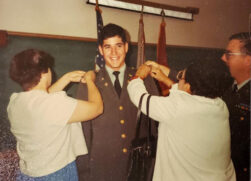
John Chavez commissioning in the U.S. Army on May 16, 1986, at Dow Hall on the NMMI campus. Second lieutenant bars being pinned by his mother, Rosalyn Chavez, and his grandmother, Ruby Chavez.
Submitted photos
But John struggled in a typical educational setting. It was never easy to be the namesake and only grandson of John E. Aragon, a longtime educator who had served as Belen’s director of instruction from 1954 to 1967 and its superintendent of schools from 1967 to 1975.
John thought the New Mexico Military Institute might be a good option for him to explore. He jokes that when his parents told him he needed to improve in school or they would have to send him to a military school, it was no threat at all. He gladly answered, “OK.”
John remembers when a NMMI recruiter visited him and his family at their home on North Fifth Street. The recruiter painted a favorable picture of the military school, claiming that 98 percent of the students who entered the program successfully completed it.
John and his parents were impressed. Without ever seeing the NMMI campus, they agreed that John would begin high school there in the fall of 1981. They could not have realized that they had made a decision that would change John’s life forever.
Getting started
John remembers his parents driving him to Roswell to start school in August 1981. He met a large RAT (Recruits At Training) class from all parts of the United States and the world. John noticed that quite a few students came from Roswell itself.
John’s class of cadets included several females. While some females had previously attended NMMI as day students, the largely male institution became a truly coed school in August 1977.
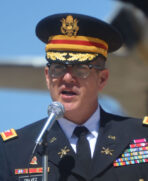
John Chavez retired from the U.S. Army in 2013 as a full colonel.
News-Bulletin file photo
As at other military schools of its kind, the transition had not always gone smoothly, but John says that by 1981 females represented about 10 percent of all students and held leadership positions throughout the Corps of Cadets.
NMMI was a shock to most RATs, male or female. Many were not used to the dry desert heat of southern New Mexico. Others struggled with the rigorous physical demands of the program, especially during RAT Week with its intense indoctrination and constant drills, especially marching. No phone calls were allowed; the only contact with family and friends was through the mail. Some cadets grew homesick. Quite a few dropped out.
Then there were the vigorous rules and military discipline. Cadets received a manual called the Blue Book, filled with exacting rules they were expected to follow. New cadets had to memorize whole sections of the book and be prepared to quote them verbatim if ordered to do so by upperclassmen.
Barracks were inspected regularly. Lockers were to be kept in good order, with properly folded clothes, socks and towels. Uniforms had to be kept clean and shoes had to be shined perfectly. These rules were so engrained in John that he abides by them to this day, as his wife, Holly, can attest.
A typical day
Cadets lived in a highly-structured environment filled with strict rules and tight schedules. Rising at 6 a.m., cadets cleaned and dressed quickly in preparation for formation at 6:15 and breakfast at 6:30.
Classes started at 8 a.m. and ran through the morning and most of the afternoon. Dinner was served at 5:30 p.m. with formation to follow. An evening study hall lasted 2 1/2 hours with no TVs or radios allowed. Cadets had just one-half hour of free time before they showered and prepared for taps at 10 p.m.
John admired all his instructors at NMMI, but admits to having a favorite. Lt. Col. William “Bill” Gibbs had taught history at NMMI since 1976 and was chairman of the Department of Social Sciences by the time John enrolled in his classes.
Gibbs was universally respected not only for his academic skills, but also for his genuine concern for his students. Years later, John learned that Gibbs kept 3×5 index cards with the name and address of every cadet in his classes so he could remember his students and stay in touch with them in the future.
Bill Gibbs was the main reason John majored in history. But there were other people who helped him love the subject. His grandfather, John Aragon, taught him about the history of their family and encouraged him to navigate through his family’s Encyclopedia Britannica, with one topic leading to another. He also taught John that there is hardly anything new in the world, only new takes on old ideas.
John’s grandmother, Ruby Chavez, also taught him about their family’s history with stories about his ancestors with “some legend weaved in,” John says. “But that only made them more enchanting.”
While not required to join the military after graduating from NMMI, cadets were required to take Army Junior ROTC classes in high school and Army ROTC classes in NMMI’s junior college. Junior college graduates who completed U.S. Army training requirements earned Army commissions as second lieutenants.
John describes his life at NMMI as very institutionalized, but ironically liberating. Cadets knew the rules or boundaries of their lives and enjoyed the freedom of life within them. Once acclimated to life in a military school, few students had authority issues.
John and most of the cadets who returned to school each year progressed smoothly from one level of responsibility to the next, growing as individuals and as leaders.
Deportment
Like all military institutions, NMMI had strict rules, as specified in its Blue Book and honor code. Misbehavior was seldom tolerated. Older cadets could order new cadets to drop and “give them” 10 pushups for the smallest infraction. Cadets received grades for deportment, just as they received grades for academic courses like math and English.
In addition to dictating daily behavior, the Blue Book stressed the students’ most important ethical and moral values, known as the honor code. According to this time-honored code, cadets “will not lie, cheat, or steal nor tolerate those who do.” Serious consequences, including a dishonorable expulsion, could result if a cadet was found guilty of an honor code violation.
Roswell of the early 1980s offered few distractions in the days before its UFO craze and increased tourism. John says the town was so isolated and quiet that there was really no place to go AWOL (absent without leave).
That didn’t mean that cadets did not get into trouble of one kind or another. Punishable behavior included everything from drug and alcohol use to secretly being married. A person could lose rank in the former case or be expelled from school in the latter.
For lesser “crimes” like skipping classes, cadets received a designated number of demerits and appropriate punishment. A cadet could, for example, receive five demerits and get from one to a whole weekend of marching tours, with each tour equaling an hour of marching back and forth with a rifle. Those who accumulated a hundred demerits faced a semester’s suspension.
The worst punishment a cadet could receive was a dishonorable expulsion, known as being drummed out of the corps in a public shaming. In a dramatic event, the Corps of Cadets stood at attention in two long rows. A drum rolled as the guilty party was made to walk the entire distance between the lines of his or her former fellow cadets.
Streaking and hazing
John says that NMMI had been nationally famous for its streaking tradition, dating back many years and even reported on by Paul Harvey on his nationwide radio show. The last streak John recalls was during his RAT year. It resulted in more than a few apprehensions by the Roswell police. Now banned, streaking can lead to expulsion.
Hazing, with all its potential abuse, was also banned by the early 1980s. NMMI cadets had previously hazed new cadets with “zoom brooms,” or brooms wrapped in duct tape and used as a weapon by older cadets to initiate new ones.
“Blood bars” were marks made on a RAT’s chest by striking the cadet with a sharp thin object. Hazed in this manner, cadets often suffered welts, although their welts were easily covered by bandages to conceal detection.
Hazing at NMMI and most schools in the country could result in tragic consequences. The practice was banned at NMMI to prevent such calamities, but many students still considered hazing a rite of passage and an act of acceptance into the cadet corps. John recalls that many cadets willingly continued using “zoom brooms” the year it was banned.
Traditions
Like most old schools, NMMI had many traditions that helped define its identity and culture. The Goss Rifle precision drill team, for example, won many regional and national championships.
John recalls how impressed he was when he watched the team perform expertly with their rifles, bayonets and black helmets. John’s future brother-in-law, Danny Hansen, was a proud member of the Goss Rifle team.
“Etiquette Dinners” were given, although all dinners were eaten formally. Etiquette dinners allowed students to enjoy elaborate meals while displaying their dining manners. “Legacy Dinners” were held routinely to honor cadets whose parents, grandparents and even great-grandparents had attended NMMI.
The Bronco is NMMI’s mascot. A mosaic of the Bronco is on the floor of the dining facility and anyone who accidentally steps on it is required to do 10 push-ups while kissing the Bronco’s tail end.
John recalls a visit by Major Gen. Edwin Baca, then the state’s adjutant general. Not knowing the tradition, the honored guest stepped on the Bronco; those who witnessed the misstep moaned in shock. Gen. Baca asked what he had done wrong and, once informed, promptly dropped to the floor and did his 10 push-ups like everyone else.
R&R
With all their studies and activities, cadets still managed to enjoy some R&R (rest and relaxation). Students who came from Roswell could go home on the weekends. Those who lived further away went home on the holidays or welcomed weekend visitors.
John’s parents often visited from Belen on Sundays. The family usually went to church, had lunch and visited the small local zoo or a park before it was time to take John back to his barracks. John was always grateful that his parents took the time, traveling the 200 miles each way to spend time with him and maintain their strong family bonds.
Most cadets enjoyed playing intermural or team sports, from swimming and golf to football and basketball. Bill Gibbs and other professors encouraged students to join or organize clubs if they expressed an interest in a particular subject or activity.
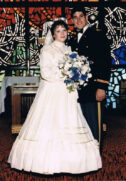
John and Holly Chavez at their wedding on May 23, 1987, at the NMMI Chapel.
John remembers belonging to the League of United Latin American Citizens (LULAC), the First Sergeants Club and the Disciplinary Board. He spent most of his out-of-class time serving as the athletic trainer for the school’s basketball team. His work in this role led to an athletic scholarship for his junior college years.
The school has a number of ghost stories and other legends that have evolved over the years. When John attended, it was rumored that there was an Army tank buried beneath the school as well as a whole network of secret tunnels below the campus.
Under the cover of darkness, John and a fellow cadet sought to discover and explore the secret tunnels. After searching for several hours, they found some crawl space under the barracks and a utility tunnel that connected several buildings. As with most myths, the legend proved far better than the reality.
During John’s last year, Hollywood came to NMMI. A made-for-television series titled “Dress Gray” was filmed on campus with many cadets serving as extras. Alec Baldwin played the starring role in this murder mystery. Several cadets taught Baldwin how to march and carry a saber without inflicting harm to himself or others.
Hal Holbrook, Lloyd Bridges, Eddie Albert and Susan Hess, the male cadets’ favorite, were among the other stars seen on campus. Although John was not in the film, his dorm room was. In one scene, Hal Holbrook looked out John’s dorm window onto Hagerman Barracks, commonly known as “The Box.”
Given the 9:1 ratio of male to female cadets, male cadets often socialized with girls in town, especially at dances held once a month on the NMMI campus. Once a year, girls from Radford School in El Paso, Texas, were bussed in for a special dance as well.
John’s future wife, Holly Hansen, also attended NMMI. They met at the Christmas Dance held on Dec. 14, 1985. In 1987, they married in the campus chapel with many of their families, friends and former professors in attendance.
Graduation and two careers
John graduated from high school at NMMI in 1984. He remained at the school for his first two years of college before transferring to New Mexico State University. He majored in history and finished his bachelor’s degree in 1989.
John received his commission the same year as his graduation from junior college and began his Army career in the New Mexico Army National Guard. While most NMMI graduates completed their two-year military obligation, a majority did not make the military their career. John was the exception.
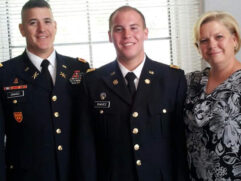
John Chavez II Commissioning in the U.S. Army on May 12, 2012, at Pearson auditorium on the NMMI campus with parents John and Holly Chavez.
John’s military career spanned 27 years, with duty assignments in Korea (twice), Germany, the War College and four tours of duty at Ft. Bliss in El Paso. He also completed three combat tours in Saudi Arabia and Iraq during Operations Desert Shield and Desert Storm, Kuwait for Operation Desert Thunder and throughout the Middle East for Iraqi Freedom. Achieving the rank of full colonel, John retired in 2013.
Returning to his hometown of Belen, John was first appointed and then elected a state magistrate court judge in 2014. Reelected in 2018, he has held the position ever since.
Rising to leadership roles as in all his life, John was elected vice president of the New Mexico Magistrate Judges Association in 2015 and currently serves on several Judicial and State Commissions, including the Judicial Budget Committee, the Judicial Education and Training Advisory Committee and the New Mexico Sentencing Commission. John also writes a column about our judicial system for the News-Bulletin.
Benefits to last a lifetime
John appreciates all the things he learned at NMMI, in the classroom, on the field, in the dorms and in the Corps of Cadets. He knows that the values his family had taught him were reinforced and refined. In his five years, he became more physically fit and disciplined than he had ever expected to be at that stage of his life.
Most importantly, John appreciates how NMMI helped shape his life as a leader. He calls NMMI a “leadership laboratory,” where young men and women grow from adolescence to adulthood with the skills to become strong leaders. In John’s words, “It’s all about investing in people to help them become productive leaders.”
One of John’s most vivid memories of becoming a good leader occurred in his senior year of high school when he was chosen to serve on the cadre of cadets who would help train the new RAT class. The Commandant, Lt. Col. Alva Brownfield, gave a class on leadership, repeating a lot of what John had heard before in his JROTC classes. But this time, John says that “it all clicked and made perfect sense.”
Lt. Col. Brownfield stressed that leading people is a process of influencing them and, because you are dealing with people, it is by its very nature personal. If you begin a relationship with personal respect, trust will usually follow.
John experienced many leadership styles, both good and bad at NMMI and, later, in the Army. Poor leaders include micromanagers and those that lead through fear and intimidation. Other poor leaders demonstrate indifference to those they are supposed to lead.
Good leaders show compassion and understanding and are still able to make difficult decisions that, at the time and in their opinion, are most effective.
As the bedrock of his youth, NMMI gave John the tools, courage and training to face nearly every challenge in life. But he could not have become an exemplary leader in the Corps of Cadets, in the Army or in the courtroom without the personality, character and values that are his alone. At every stage of his life, John has maintained a remarkable balance of fairness, compassion and honorable respect for the law, be it NMMI’s Blue Book, military jurisprudence or New Mexico state law.
Family and legacy
John and Holly have five children, Rosemary, Noelle, John II, Sebastian and Nicolas. They are glad to make their home in Belen where John’s family has such deep roots and where John enjoyed his small-town upbringing.
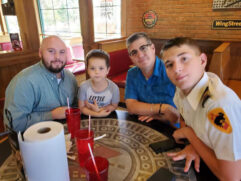
John II, John III, John and Nicolas Chavez visiting in Roswell, N.M.
John and Holly’s children have had different interests and have chosen different paths. Their oldest son, John II, attended NMMI like his father and mother. After graduating from NMMI’s high school and junior college, he was commissioned a second lieutenant and served in the New Mexico Army National Guard. John’s youngest son, Nicolas, is currently a cadet at NMMI.
John’s young grandson, John III, knew the NMMI’s fight song by the time he was 4 years old. He looks forward to attending what he calls “warrior school.”
John was proud to deliver the commissioning address at NMMI on Dec. 15, 2011. His speech reflected his deep gratitude for the school where he learned so much about life and leadership. It was a heartfelt speech, but the day was made even more special because the night before was the anniversary of the day when John met Holly. In a scene like no other, the cadet chorus, including their son John II, serenaded John and Holly.
With his two sons attending NMMI, John’s proud legacy has come full circle and now, he hopes, it will continue into the future when John III goes to “warrior school” like his father, uncle, grandmother and grandfather proudly did before him. John Chavez’s “Legacy Dinner” table promises to be very joyful and very crowded.
(Those interested in joining the Valencia County Historical Society should contact its president, Richard Melzer, at [email protected].)
(La Historia del Rio Abajo is a regular column about Valencia County history written by members of the Valencia County Historical Society since 1998.
Opinions expressed in this and all columns of La Historia del Rio Abajo are the authors’ alone and not necessarily those of the Valencia County Historical Society or any other group or individual.)
The Valencia County News-Bulletin is a locally owned and operated community newspaper, dedicated to serving Valencia County since 1910 through the highest journalistic and professional business standards. The VCNB is published weekly on Thursdays, including holidays both in print and online.


